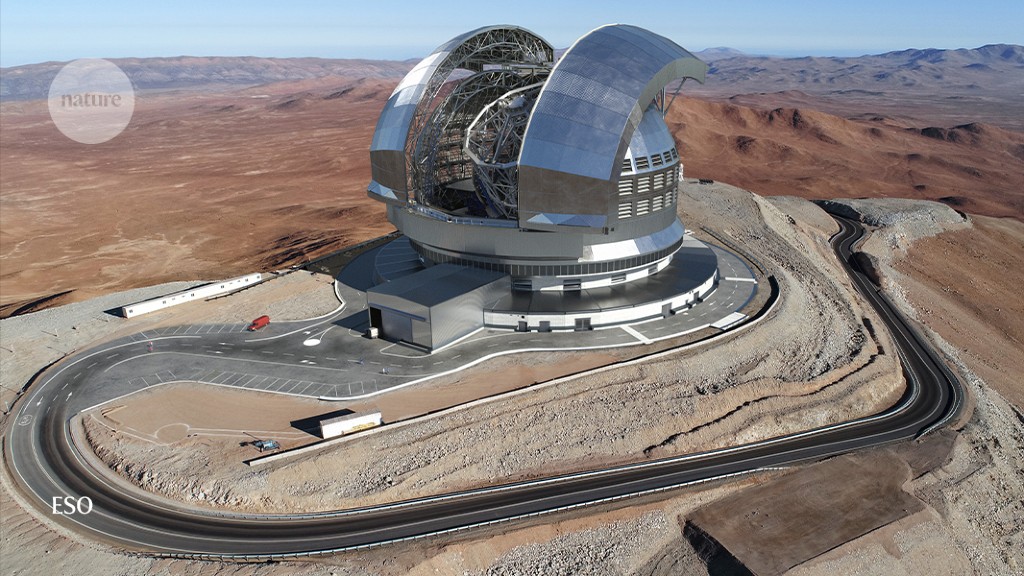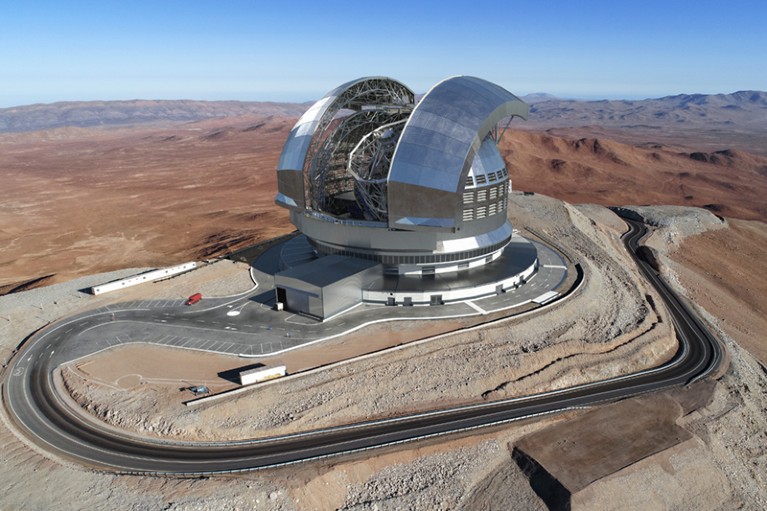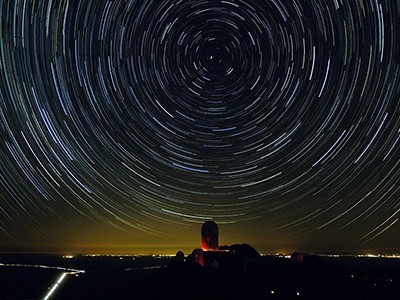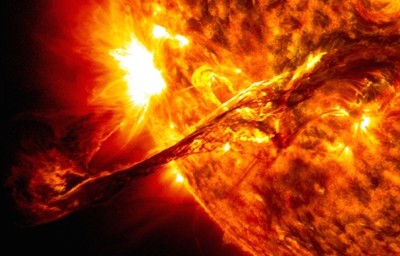An artist’s impression of the Extremely Large Telescope — one of the projects supported in Astronet’s 2008 astronomy roadmap that is currently under construction.Credit: ESO
A list of the astronomy projects that European funding agencies should prioritise has been unveiled by Astronet, a network of European funding agencies and research organisations.
Among the recommendations are a new wide-field spectroscopic telescope, support for the Einstein Telescope — a gravitational wave detector still at the concept stage — and the European Solar Telescope, which will study the Sun’s magnetic field. Space-based missions include a follow-up to the Gaia spacecraft that is mapping billions of stars.
US astronomy’s 10-year plan is super-ambitious
“I was particularly excited to see the nature of dark matter and dark energy marked out as key unanswered questions,” says Priyamvada Natarajan, an astronomer at Yale University in New Haven, Connecticut.
Astronet came up with its 2022-2035 astronomy roadmap after consulting with the academic community for nearly three years, says Amelie Saintonge, an astrophysicist at University College London who edited the final report. The consultation process involved several working groups of researchers who advised on the scientific priorities in their field and the technology needed to achieve their research goals.
Balancing the needs and wishes of the entire community was a big part of the process, says Saintonge. “If you look at some of our top recommendations in terms of ground-based facilities, you have, for example, the European Solar Telescope, which is a facility that really is most of interest for the solar physics community,” she says. “Next to that we have recommendations of other facilities that are far more general,” she adds, for example a new spectroscopic telescope that could see really distant galaxies in large spectroscopic surveys. “One of the reasons we prioritise that is because it is of appeal to essentially all science areas, it would be a very versatile facility,” says Saintonge. “At this time, strategically, you need that kind of spectroscopy facility to follow up and make the most of many other things that are upcoming.”
Continuing support
This is the second time Astronet has produced a roadmap for European astronomy. The first was published in 2008, and updated in 2015. Since then, Astronet has become independent of the European Commission — which hosted the network until 2015.
The network’s 2008 roadmap recommended that funders prioritise the 42-metre Extremely Large Telescope and the Square Kilometer Array — both large infrastructure projects that are now being built. The latest report recommends ongoing support for these telescopes. “It’s a bit of a continuum from previous reports,” says Colin Vincent, chair of Astronet’s board, and associate director for astronomy at the UK science and technology facilities council.
The roadmap overlaps with other long term planning reports such as the European Space Agency’s Voyage 2050 programme and the United States National Academies of Science decadal survey, which sets out research priorities and was released in 2021.
Space-weather forecast to improve with European satellite
This report is in some ways the European counterpart of the decadal survey, explains Saintonge, “but at the same time, it’s quite a different exercise”. The US version has a budget attached to it, and is often seen as binding: the recommendations are the projects that will be funded. “This is much more of a community driven effort and much more European astronomers establishing a wish list of what they would like to see.”
“It’s not just about the big facilities, it’s about all ecosystem of facilities,” adds Saintonge. “That means funding computing, machine learning, AI,” she says, along with investment in training.
The latest roadmap also includes recommendations that sustainability and diversity are prioritised in funding decisions. “Everybody wanted to see in there a strong component about sustainability, and the impact of astronomy research on society and the planet.”
Jean-Marie Hameury, an astrophysicist at the Observatory of Strasbourg in France, led the first Astronet roadmap and is pleased that a follow up has been produced. European astronomy needs long-term planning in the broadest sense, he says. “There is a need for such a thing that covers both ground and space aspects. And also all wavelengths.”










More News
Author Correction: Stepwise activation of a metabotropic glutamate receptor – Nature
Changing rainforest to plantations shifts tropical food webs
Streamlined skull helps foxes take a nosedive